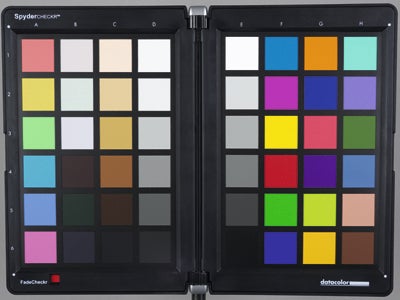The GH3 is the largest mirrorless camera we’ve laid hands on but is it ready to take on DSLR competition?
Panasonic Lumix GH3 Review
Image Quality
Tone & Exposure
We were provided with excellent exposures when we went out shooting with the GH3. The 144-zone metering system coped with tricky scenes very well and wasn’t put off by a stark contrast between bright highlights and dark shadows. Exposure was so accurate that the maximum amount of exposure compensation we dialled in was 0.7EV, but if you wanted to get creative with your exposures there’s a dedicated button on the top plate that lets you set it between -5EV and +5EV.

To view our GH3 review sample image gallery, click here.
White Balance & Colour
With our daylight balanced lamps shining down on our Datacolor Spyder Checkr chart we were able to get a better understanding of how accurately the GH3 renders colour and White Balance. Just like the chart itself, our results between ISO 125 and 1600 were vibrant, punchy and rich in colour. There were no signs of the saturation decreasing as we increased the ISO range, that was until we reached ISO 25,600 where the colours were slightly more muted compared to those at 12,800.

To view our GH3 review sample image gallery, click here.
Sharpness & Detail
Using a physically smaller sensor than an APS-C sized chip, the GH3 has its work cut out if it’s to compete with the larger sensors used by other CSC and DSLR manufacturers. Shooting our test chart revealed the 16MP sensor was capable of rendering 32 lines per millimeter at ISO 100 when coupled with the 45mm f/2.8 Macro Leica D Vario-Elmarit lens. While this is very impressive for a Micro FourThirds chip, APS-C sensors have scored slightly higher in the past.

To view our GH3 review sample image gallery, click here.
Image Noise
We started our ISO testing by expanding the GH3’s sensitivity to its maximum 125-25,600 equivalent range. Clean, noise-free images are produced between ISO 125 and ISO 800 but as we noticed, noise begins to creep in at ISO 1600. The results at this setting and ISO 3200 are certainly useable, but if you plan on printing your images at a large size then be aware it may be visible to the naked eye. Push past ISO 6400 and noise starts to degrade image quality so try and avoid ISO 12,800 and 25,600.
Raw vs JPEG
Comparing an unprocessed Raw file up against a processed JPEG revealed subtle differences. JPEG files are slightly brighter in dark shadowed areas whereas Raw files resolve more detail in the highlights. Side by side we noticed JPEG files have fractionally more contrast applied and at 200%, in-camera sharpening was clearly obvious in JPEG files with some image noise control applied.




